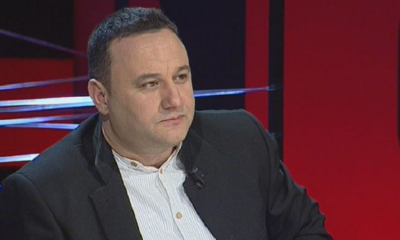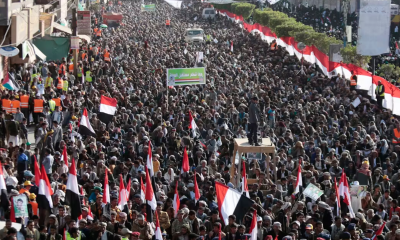Art & Culture
Mehmed Özçay

Mehmed Özçay, who was born on 4 July 1961 in the Şahinkaya village of the Çaykara district in Trabzon, completed his primary and secondary education in 1980 in Gerede. He graduated from the Faculty of Theology at Erzurum Ataturk University in 1986. He studied the Thuluth and Naskh scripts with calligrapher Fuad Başar from Erzurum whom he met there in 1982 and received his ijazah (license) from him in 1993. In 1986, he arrived in Istanbul and met with M. Uğur Derman. This meeting marked the beginning of their unending teacher-student bond which contributed to fostering his appeal for calligraphy and to broadening his knowledge and horizons.
Özçay participated in the first two international calligraphy competitions held by the Research Centre for Islamic History, Art and Culture (IRCICA) winning six awards in a variety of categories and most notably the first prize in the category of Thuluth-Naskh scripts. He completed his copy of the Holy Quran in 1991, which he had begun in 1986, and published his first copy in 1992. This manuscript of the Quran was a significant milestone especially since it facilitated his progress in the Naskh script and played a pivotal role in encouraging him to adopt calligraphy as a profession.
Furthermore, Özçay who had published print reproductions of many of his works, also compiled two albums in 2007, featuring select pieces spanning twenty-five years of his art career; “Nuru ‘Ayni” in Arabic and “Spoken by the Hand Heard by the Eye” in English. Moreover, within the field of calligraphy, he contributed with his experience to numerous scholarly publications with photographs he had taken and his expertise on technical aspects of the art.
Özçay, who continues to serve as a jury member and consultant in numerous international calligraphy competitions, has participated in many domestic and international exhibitions.
Among these exhibitions are the following:
- Kazma Islamic Culture Festival, 1996, Kuwait
- Islamic World Calligraphy Festival, 1997, Tehran
- International calligraphy exhibition “Wonders of Arab Calligraphy”, 1999, Riyadh
- International “Arab Calligraphy Days”, 1999, Tunisia
- International “Holy Quran Exhibition”-2000, Tehran
- “National Calligraphy Festival”, 2001, Tunisia
- “Calligraphy Exhibition”, 2003, Tokyo
- “Salam and Calligraphy”, 2003, Doha
- “International Calligraphy Biennial”, 2004, Sharjah
- “International Arabic Calligraphy Exhibitions” held in 2004, 2005, 2006, 2007, 2008, 2010, 2012, 2015 and 2017, Dubai
- Emirates Through Arab Eyes, 2008, UAE
- 3rd Kuwait International Islamic Arts Congress, 2008, Kuwait
- Qatar International Calligraphy Exhibition, 2010, Qatar
- International Most Famous Quran Manuscript Calligraphers’ Convention, 2011, Madinah
- “Hulum Fares”, 2012, Istanbul
- “International Gathering on the Art of Calligraphy”, 2014, Istanbul
- “International Calligraphy Biennial”, 2014, Sharjah
- “Beirut American University International Calligraphy Exhibition and Symposium”, 2017, Beirut
- Yeditepe Biennial, 2018, Istanbul
- Yıldız Holding Asma-i Nabi Exhibition, 2018, Istanbul
- International Riyadh Art Exhibition MiSK, 2018, Riyadh
Özçay held his first solo exhibition together with his siblings Osman Özçay and Fatma Özçay in May 1996 in Yıldız Palace, Istanbul. Later, “Özçay” calligraphy exhibitions were held in National Culture Foundation in Istanbul in 1998, in Qatar-Doha in November 1998, in Abu Dhabi in December 1998, in Sharjah in 1999, in Dubai in 2003 and in Abu Dhabi International Book Fair in 2017.
After two years of rigorous work together with the calligraphy team that he formed, he wrote the calligraphies for the King Abdullah Makkah Masjid al-Haram Expansion Project which he completed in 2015. In March 2018, Özçay received an honorary doctorate degree from Suleyman Demirel University and was appointed as a member of the Turkish Presidential Council of Culture and Arts Policies.
He added a new dimension to his works, especially in the Jali scripts, by utilizing coloured and transparent ink and thus revealing and highlighting all the pen movements. He introduced an innovative and unique style into the karalama (scribble) tradition when using coloured scribble in the Jali Thuluth and Jali Naskh scripts for the first time ever. Özçay pioneered a new era by using coloured and transparent inks in the classical Ottoman calligraphy tradition. He is dedicatedly conveying his expertise and knowledge to his students in order to nurture future generations of calligraphers.
Özçay who loves to travel, witness nature and who also has an interest in the art of photography has hundreds of works in the Jali Thuluth, Thuluth, Naskh, Ijazah and Jali Diwani scripts featured in various museums, private collections and mosques both within Turkey and abroad.

You may like
-


Israel will collapse when God fulfills Iranian nation’s ‘Death to America’ prayer: Albanian historian
-


“Western Double Standards in Addressing Conflicts in the Middle East and Ukraine”
-


“Harris-Trump Debate Sparks New Controversies in U.S. Political Landscape”
-


“Netanyahu’s Strategy Crumbles as Hezbollah Expands Battlefield: Refugee Crisis Worsens”
-


The inspiration of Iran’s Islamic revolution on Yemen’s Islamic resistance movements
-


Islamic Resistance of Yemeni Shiites based on religious beliefs and values


Iran is a barrier to Israeli regional ambitions: Alan Ned Sabrosky

Iran’s Anti-Hegemony Stance Strengthens, Cementing Its Role as Region’s Most Independent Nation

Israel will collapse when God fulfills Iranian nation’s ‘Death to America’ prayer: Albanian historian

Bloodshed in the Shadows: West Bank Crisis Deepens as Gaza Dominates Headlines

An anti-Semite is now someone Jews don’t like

Bloodshed in the Shadows: West Bank Crisis Deepens as Gaza Dominates Headlines

Iran’s Anti-Hegemony Stance Strengthens, Cementing Its Role as Region’s Most Independent Nation

Israel will collapse when God fulfills Iranian nation’s ‘Death to America’ prayer: Albanian historian

Iran is a barrier to Israeli regional ambitions: Alan Ned Sabrosky

Jewish parties foreign policy

Will Israel adhere to its commitments under the ceasefire agreement?

“Western Double Standards in Addressing Conflicts in the Middle East and Ukraine”

“Harris-Trump Debate Sparks New Controversies in U.S. Political Landscape”

Challenges Facing the U.S. Navy: Addressing Gaps in Strategy and Capability







